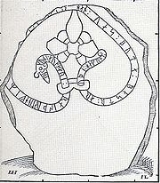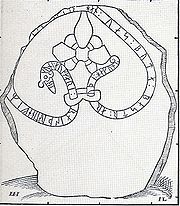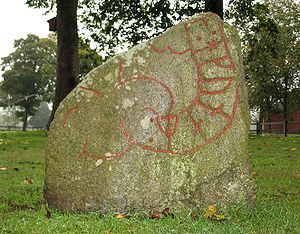
Hakon Jarl Runestones
Encyclopedia
The Hakon Jarl Runestones are Swedish runestones from the time of Canute the Great
.
Two of the runestones, one in Uppland
(U 617) and one in Småland
(Sm 76) mention a Hakon Jarl, and both runologists
and historians have debated whether they are one and the same, or two different men. Moreover, all known Hakon Jarls have been involved in the debate: Hákon Sigurðarson
(d. 995), his grandson Hákon Eiríksson
(d. 1029), Hákon Ívarsson (d. 1062) and Hákon Pálsson (d. 1122). The most common view among runologists (Brate, von Friesen, Wessén, Jansson, Kinander and Ruprecht) is that the two stones refer to different Hakon Jarls and that one of them was Swedish and the other one Norwegian.
 This runestone was located in Nibble on the island of Ekerö
This runestone was located in Nibble on the island of Ekerö
, but it has disappeared. In scholarly literature it was first described by Johannes Bureus
(1568–1652), and it was depicted by Leitz in 1678. Johan Hadorph
noted in 1680 that the name of the deceased in the inscription had been bitten off by locals who believed that doing so would help against tooth ache. Elias Wessén
notes that roði HakonaR refers to a leidang
organization under a man named Hákon who could have been a jarl, but he considers it most likely that Hákon refers to the Swedish king Hákon the Red. Others identify Hákon with the Norwegian jarl Hákon Eiríksson
, like Sm 76, below, and Omeljan Pritsak
considers the man to whom the stone was dedicated to have been a member of the army of jarl Hákon Eiríksson
in England
.
Latin transliteration:
Old Norse transcription:
English translation:
. However, the only recorded organization of such a defence is from England
and consequently both this Hakon Jarl and his son Özurr may have been active in England in the Þingalið
instead. Omeljan Pritsak
argues that this Hakon is the same as the one who is mentioned on the Södra Betby Runestone and whose son Ulf was in the west, i.e. in England. This Swedish Hakon Jarl would then actually be the Norwegian Hákon Eiríksson.
Like the Norwegian jarl Hákon Eiríksson, this Swedish Hakon Jarl has been identified with the Varangian chieftain Yakun
who is mentioned in the Primary Chronicle
.
The reference to bridge-building in the runic text is fairly common in rune stones during this time period. Some are Christian
references related to passing the bridge into the afterlife. At this time, the Catholic Church sponsored the building of roads and bridges through the use of indulgence
s in return for intercession for the soul. There are many examples of these bridge stones dated from the eleventh century, including runic inscriptions Sö 101 and U 489.
Latin transliteration:
Old Norse transcription:
English translation:
 Only a fragment remains of this runestone, but before it was destroyed, the text had been read by runologists. The fragment is located in the garden of the inn of Komstad in Småland
Only a fragment remains of this runestone, but before it was destroyed, the text had been read by runologists. The fragment is located in the garden of the inn of Komstad in Småland
. It was originally raised by a lady in memory of Vrái who had been the marshall of an earl Hakon, who was probably the earl Håkon Eiriksson
. Some time earlier, Vrái had raised the Sävsjö Runestone in memory of his brother Gunni who died in England.
The generally accepted identification with Hákon Eiríksson was made by von Friesen in 1922, and he is also held to appear on U 16, above.
Latin transliteration:
Old Norse transcription:
English translation:
Canute the Great
Cnut the Great , also known as Canute, was a king of Denmark, England, Norway and parts of Sweden. Though after the death of his heirs within a decade of his own and the Norman conquest of England in 1066, his legacy was largely lost to history, historian Norman F...
.
Two of the runestones, one in Uppland
Uppland
Uppland is a historical province or landskap on the eastern coast of Sweden, just north of Stockholm, the capital. It borders Södermanland, Västmanland and Gästrikland. It is also bounded by lake Mälaren and the Baltic sea...
(U 617) and one in Småland
Småland
' is a historical province in southern Sweden.Småland borders Blekinge, Scania or Skåne, Halland, Västergötland, Östergötland and the island Öland in the Baltic Sea. The name Småland literally means Small Lands. . The latinized form Smolandia has been used in other languages...
(Sm 76) mention a Hakon Jarl, and both runologists
Runology
Runology is the study of the Runic alphabets, Runic inscriptions and their history. Runology forms a specialized branch of Germanic linguistics.-History:...
and historians have debated whether they are one and the same, or two different men. Moreover, all known Hakon Jarls have been involved in the debate: Hákon Sigurðarson
Haakon Sigurdsson
Haakon Sigurdarsson was the de facto ruler of Norway from about 975 to 995.-Background:Haakon was the son of Sigurd Haakonsson, Jarl of Lade and ruler of Trøndelag and Hålogaland. His mother was Bergljot Toresdatter, daughter of Tore Ragnvaldsson, Earl of Møre...
(d. 995), his grandson Hákon Eiríksson
Håkon Eiriksson
Håkon Eiriksson was Earl of Lade and king of Norway as a vassal under Knut the Great.Håkon Eiriksson was from a dynasty of Norwegian rulers in the eastern part of Trondheim, bordering the Trondheimsfjord. He was the son of Eirik Håkonson, ruler of Norway and earl of Northumbria...
(d. 1029), Hákon Ívarsson (d. 1062) and Hákon Pálsson (d. 1122). The most common view among runologists (Brate, von Friesen, Wessén, Jansson, Kinander and Ruprecht) is that the two stones refer to different Hakon Jarls and that one of them was Swedish and the other one Norwegian.
U 16

Ekerö
Ekerö is a locality and the seat of Ekerö Municipality in Stockholm County, Sweden, with 10,322 inhabitants in 2005.Agnetha Fältskog of ABBA fame lives on the island ....
, but it has disappeared. In scholarly literature it was first described by Johannes Bureus
Johannes Bureus
Johannes Thomae Bureus Agrivillensis was a Swedish antiquarian, polymath and mystic. He was royal librarian, tutor, and adviser of King Gustavus Adolphus of Sweden....
(1568–1652), and it was depicted by Leitz in 1678. Johan Hadorph
Johan Hadorph
Johan Hadorph was a Swedish director-general of the Central Board of National Antiquities. In 1667, he was appointed assessor at the government agency for antiquities, and in 1679, he became its director-general...
noted in 1680 that the name of the deceased in the inscription had been bitten off by locals who believed that doing so would help against tooth ache. Elias Wessén
Elias Wessén
Elias Wessén was a prominent Swedish linguist and a professor of Scandinavian languages at Stockholm University . In 1947, he was honoured with one of the 18 seats at the Swedish Academy .His earliest work concerned morphological problems in the Germanic languages, Onomasiology and Norse mythology...
notes that roði HakonaR refers to a leidang
Leidang
The institution known as leiðangr , leidang , leding, , ledung , expeditio or sometimes lething , was a public levy of free farmers typical for medieval Scandinavians. It was a form of conscription to organise coastal fleets for seasonal excursions and in defence of the realm...
organization under a man named Hákon who could have been a jarl, but he considers it most likely that Hákon refers to the Swedish king Hákon the Red. Others identify Hákon with the Norwegian jarl Hákon Eiríksson
Håkon Eiriksson
Håkon Eiriksson was Earl of Lade and king of Norway as a vassal under Knut the Great.Håkon Eiriksson was from a dynasty of Norwegian rulers in the eastern part of Trondheim, bordering the Trondheimsfjord. He was the son of Eirik Håkonson, ruler of Norway and earl of Northumbria...
, like Sm 76, below, and Omeljan Pritsak
Omeljan Pritsak
Omeljan Pritsak was the first Mykhailo Hrushevsky Professor of Ukrainian History at Harvard University and the founder and first director of the Harvard Ukrainian Research Institute.-Career:Pritsak began his academic career at the University of Lvov in interwar Poland where he...
considers the man to whom the stone was dedicated to have been a member of the army of jarl Hákon Eiríksson
Håkon Eiriksson
Håkon Eiriksson was Earl of Lade and king of Norway as a vassal under Knut the Great.Håkon Eiriksson was from a dynasty of Norwegian rulers in the eastern part of Trondheim, bordering the Trondheimsfjord. He was the son of Eirik Håkonson, ruler of Norway and earl of Northumbria...
in England
England
England is a country that is part of the United Kingdom. It shares land borders with Scotland to the north and Wales to the west; the Irish Sea is to the north west, the Celtic Sea to the south west, with the North Sea to the east and the English Channel to the south separating it from continental...
.
Latin transliteration:
- [kuni * auk : kari : raisþu * stin * efiR ...r : han : uas : buta : bastr : i ruþi : hakunar]
Old Norse transcription:
- Gunni ok Kari ræisþu stæin æftiR ... Hann vas bonda bæstr i roði HakonaR.
English translation:
- "Gunni and Kári raised the stone in memory of ... He was the best husbandman in Hákon's dominion."
U 617
This runestone is also called the Bro Runestone after the church by which it is located. It is raised by the same aristocratic family as the Ramsund carving and the Kjula Runestone, which allows scholars to study the family of the Hakon Jarl who is mentioned on this runestone. He is considered to have been Swedish and his son Özurr may have been responsible for organizing the local defense organization against raiders on the shores of lake MälarenMälaren
Lake Mälaren is the third-largest lake in Sweden, after Lakes Vänern and Vättern. Its area is 1,140 km² and its greatest depth is 64 m. Mälaren spans 120 kilometers from east to west...
. However, the only recorded organization of such a defence is from England
England
England is a country that is part of the United Kingdom. It shares land borders with Scotland to the north and Wales to the west; the Irish Sea is to the north west, the Celtic Sea to the south west, with the North Sea to the east and the English Channel to the south separating it from continental...
and consequently both this Hakon Jarl and his son Özurr may have been active in England in the Þingalið
Þingalið
The Thingmen was a standing army in the service of the Kings of England during the period 1013-51, financed by direct taxation which had its origins in the tribute known as Danegeld....
instead. Omeljan Pritsak
Omeljan Pritsak
Omeljan Pritsak was the first Mykhailo Hrushevsky Professor of Ukrainian History at Harvard University and the founder and first director of the Harvard Ukrainian Research Institute.-Career:Pritsak began his academic career at the University of Lvov in interwar Poland where he...
argues that this Hakon is the same as the one who is mentioned on the Södra Betby Runestone and whose son Ulf was in the west, i.e. in England. This Swedish Hakon Jarl would then actually be the Norwegian Hákon Eiríksson.
Like the Norwegian jarl Hákon Eiríksson, this Swedish Hakon Jarl has been identified with the Varangian chieftain Yakun
Yakun
Yakun or Jakun, deriving from Old Norse Hákon, was a Varangian leader who is mentioned in the Primary Chronicle and in the Cave monastery in Kiev...
who is mentioned in the Primary Chronicle
Primary Chronicle
The Primary Chronicle , Ruthenian Primary Chronicle or Russian Primary Chronicle, is a history of Kievan Rus' from about 850 to 1110, originally compiled in Kiev about 1113.- Three editions :...
.
The reference to bridge-building in the runic text is fairly common in rune stones during this time period. Some are Christian
Christian
A Christian is a person who adheres to Christianity, an Abrahamic, monotheistic religion based on the life and teachings of Jesus of Nazareth as recorded in the Canonical gospels and the letters of the New Testament...
references related to passing the bridge into the afterlife. At this time, the Catholic Church sponsored the building of roads and bridges through the use of indulgence
Indulgence
In Catholic theology, an indulgence is the full or partial remission of temporal punishment due for sins which have already been forgiven. The indulgence is granted by the Catholic Church after the sinner has confessed and received absolution...
s in return for intercession for the soul. There are many examples of these bridge stones dated from the eleventh century, including runic inscriptions Sö 101 and U 489.
Latin transliteration:
- kinluk × hulmkis × tutiR × systiR × sukruþaR × auk × þaiRa × kaus × aun × lit × keara × bru × þesi × auk × raisa × stain × þina × eftiR × asur × bunta * sin × sun × hakunaR × iarls × saR × uaR × uikika × uaurþr × miþ × kaeti × kuþ × ialbi × ans × nu × aut × uk × salu
Old Norse transcription:
- Ginnlaug, HolmgæiRs dottiR, systiR SygrøðaR ok þæiRa Gauts, hon let gæra bro þessa ok ræisa stæin þenna æftiR Assur, bonda sinn, son HakonaR iarls. SaR vaR vikinga vorðr með Gæiti(?). Guð hialpi hans nu and ok salu.
English translation:
- "Ginnlaug, Holmgeirr's daughter, Sigrøðr and Gautr's sister, she had this bridge made and this stone raised in memory of Ôzurr, her husbandman, earl Hákon's son. He was the viking watch with Geitir(?). May God now help his spirit and soul."
Sm 76

Småland
' is a historical province in southern Sweden.Småland borders Blekinge, Scania or Skåne, Halland, Västergötland, Östergötland and the island Öland in the Baltic Sea. The name Småland literally means Small Lands. . The latinized form Smolandia has been used in other languages...
. It was originally raised by a lady in memory of Vrái who had been the marshall of an earl Hakon, who was probably the earl Håkon Eiriksson
Håkon Eiriksson
Håkon Eiriksson was Earl of Lade and king of Norway as a vassal under Knut the Great.Håkon Eiriksson was from a dynasty of Norwegian rulers in the eastern part of Trondheim, bordering the Trondheimsfjord. He was the son of Eirik Håkonson, ruler of Norway and earl of Northumbria...
. Some time earlier, Vrái had raised the Sävsjö Runestone in memory of his brother Gunni who died in England.
The generally accepted identification with Hákon Eiríksson was made by von Friesen in 1922, and he is also held to appear on U 16, above.
Latin transliteration:
- [tufa : risti : stin : þina : eftiR : ura : faþur : sin : stalar]a : hkunaR : [iarls]
Old Norse transcription:
- Tofa ræisti stæin þenna æftiR Vraa, faður sinn, stallara HakonaR iarls.
English translation:
- "Tófa raised this stone in memory of Vrái, his father, Earl Hákon's marshal."
Sources and external links
- A Swedish site with a picture of the Bro Runestone.
- Brate, E. (1922). Sveriges runinskrifter. pp. 122-124.
- Jansson, Sven B. (1980). Runstenar. STF, Stockholm. ISBN 91-7156-015-7
- Pritsak, OmeljanOmeljan PritsakOmeljan Pritsak was the first Mykhailo Hrushevsky Professor of Ukrainian History at Harvard University and the founder and first director of the Harvard Ukrainian Research Institute.-Career:Pritsak began his academic career at the University of Lvov in interwar Poland where he...
. (1981). The origin of Rus' . Cambridge, Mass.: Distributed by Harvard University Press for the Harvard Ukrainian Research Institute. ISBN 0-674-64465-4 - RundataRundataThe Scandinavian Runic-text Data Base is a project involving the creation and maintenance of a database of runic inscriptions. The project's goal is to comprehensively catalog runestones in a machine-readable way for future research...

